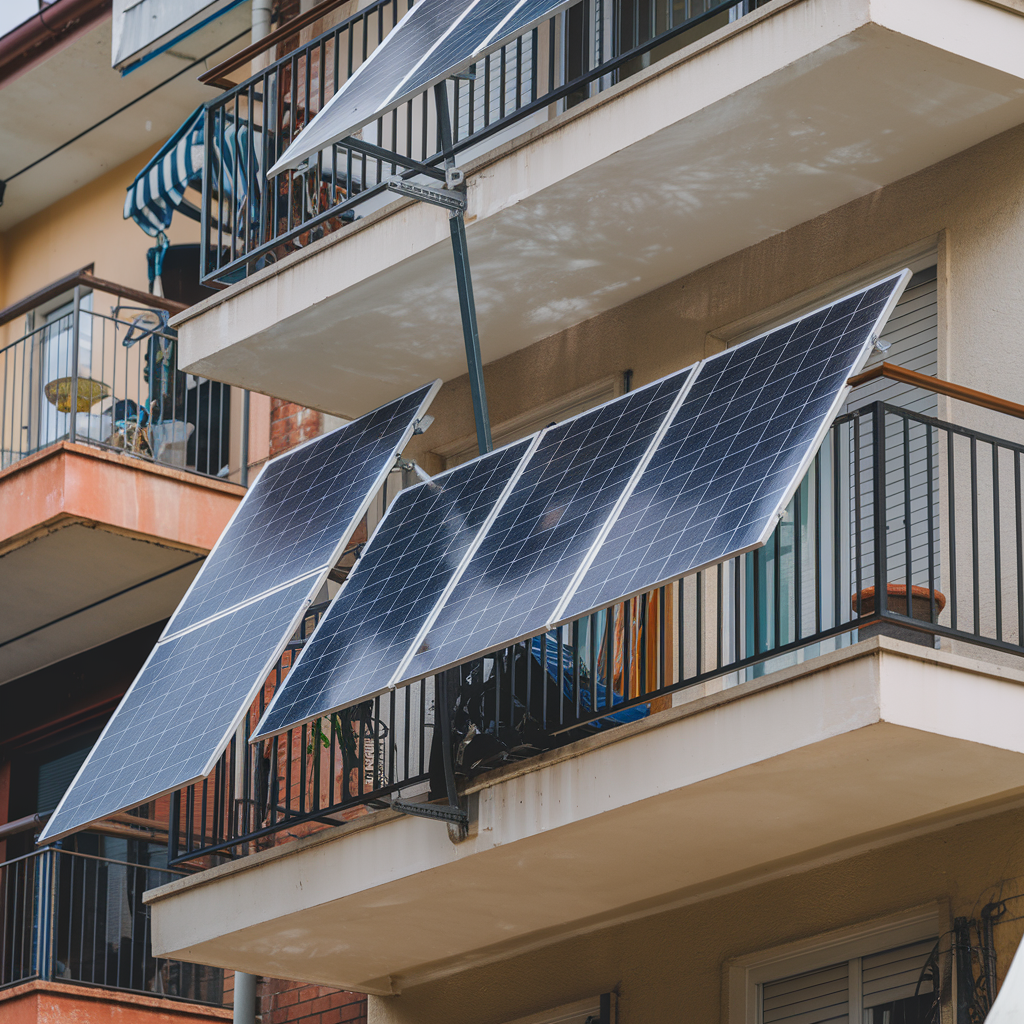In an era of rising energy costs, particularly in countries like Germany with volatile electricity markets, businesses and homeowners are increasingly turning to Balcony Energy Storage Systems. These systems allow users to store energy during off-peak hours when electricity is cheaper and use it during peak times when rates skyrocket, leading to substantial savings on electricity bills.
In this article, we’ll explore a real-world case study of a small business in Germany that installed a Balcony Energy Storage System. We’ll walk through the business owner’s journey, showing how they achieved significant savings by optimizing their electricity consumption. We’ll also provide detailed comparisons of electricity bills before and after the installation of their Balcony Energy Storage System and demonstrate how the system helped them achieve greater energy self-sufficiency in Germany’s dynamic energy market.

1. The Growing Need for Balcony Energy Storage Systems in Germany
Germany is known for its progressive renewable energy policies, but it also has some of the highest electricity prices in Europe. The country’s pricing model allows rates to fluctuate throughout the day, with peak-hour electricity costing significantly more than off-peak electricity.
For businesses and individuals alike, this creates an ongoing challenge: how to manage energy costs in a market where prices can shift dramatically within a single day. Fortunately, Balcony Energy Storage Systems provide an effective solution by enabling users to store cheaper off-peak energy and use it during peak times, reducing their reliance on expensive grid electricity.
1.1 Understanding Germany’s Energy Pricing Structure
Germany’s electricity pricing can be broken down into two primary categories:
- Peak-hour pricing: During high-demand periods, typically in the morning and evening, electricity prices can soar to €0.40 per kWh or higher.
- Off-peak pricing: During low-demand periods, such as late at night, electricity rates can fall to €0.25 per kWh or less.
For those who rely heavily on the grid during peak times, these price fluctuations can result in sky-high utility bills. However, by installing a Balcony Energy Storage System, users can store energy during off-peak hours for use during peak periods, significantly lowering their electricity costs.
2. Case Study: A Small Business’s Success with a Balcony Energy Storage System
In this case study, we’ll look at a small retail business in Berlin, Germany, that was facing the challenge of rising electricity costs due to peak-hour consumption. The business owner, determined to cut costs, decided to install a Balcony Energy Storage System to reduce their reliance on peak-hour grid electricity and smooth out their energy costs.
2.1 Pre-Installation: High Energy Bills and Peak-Hour Dependence
Before installing the Balcony Energy Storage System, the business was paying increasingly high electricity bills. Their energy consumption was concentrated around peak hours, with their operating hours from 10 AM to 8 PM falling right within the most expensive time slots.
Monthly Energy Costs Before Installing the Balcony Energy Storage System
| Month | Electricity Used (kWh) | Cost per kWh (avg) | Total Monthly Cost (EUR) |
|---|---|---|---|
| January | 1,200 | €0.38 | €456 |
| February | 1,100 | €0.39 | €429 |
| March | 1,300 | €0.37 | €481 |
| April | 1,150 | €0.38 | €437 |
With an average electricity price of €0.38 per kWh, the business owner realized that most of their energy consumption was occurring during peak hours, leading to excessively high utility bills.
2.2 The Installation of a Balcony Energy Storage System
To address these rising costs, the business owner made the strategic decision to install a Balcony Energy Storage System. The system would store low-cost energy during off-peak hours (typically late at night) and use it during the day, when electricity prices were at their highest.
System Specifications
- Battery Capacity: 10 kWh
- Inverter Capacity: 5 kW (sufficient for handling the store’s typical daytime loads like lighting, payment systems, and equipment)
- Installation Cost: €8,500 (including batteries, inverter, and labor)
- Government Incentives: The business received a 10% rebate through a local energy-saving program, reducing the upfront cost to €7,650.
2.3 Post-Installation: The Benefits of Using a Balcony Energy Storage System
After installing the Balcony Energy Storage System, the business immediately began to see savings on their electricity bills. By shifting their energy consumption from peak hours to off-peak hours, they significantly reduced their reliance on the grid during expensive times.
Monthly Energy Costs After Installing the Balcony Energy Storage System
| Month | Electricity Used (kWh) | Cost per kWh (avg) | Total Monthly Cost (EUR) |
|---|---|---|---|
| May | 1,050 | €0.26 | €273 |
| June | 1,000 | €0.25 | €250 |
| July | 1,100 | €0.27 | €297 |
| August | 1,050 | €0.26 | €273 |
By using stored energy during peak periods, the business was able to reduce its average cost per kWh from €0.38 to €0.26, resulting in monthly savings of approximately €160–€200.
3. How Balcony Energy Storage Systems Work: Maximizing Savings
The success of this small business highlights the effectiveness of Balcony Energy Storage Systems in optimizing energy consumption and reducing costs. Let’s explore how these systems work in more detail.
3.1 Storing Low-Cost Off-Peak Energy
The Balcony Energy Storage System charges during off-peak hours, when electricity prices are at their lowest. Typically, this occurs between midnight and 6 AM, when demand is low and electricity costs are reduced. By storing energy during these hours, the business avoids purchasing expensive electricity from the grid during peak times.
3.2 Using Stored Energy During Expensive Peak Hours
During the day, particularly between 10 AM and 8 PM when the store is open, the system automatically switches to using the stored energy. This reduces the need for grid electricity during the most expensive hours, allowing the business to lower its overall electricity costs.
3.3 Achieving Energy Independence with Balcony Energy Storage Systems
With a battery capacity of 10 kWh, the business was able to cover approximately 60–70% of its peak-hour energy consumption using stored energy. This level of energy independence provided significant protection against rising electricity prices and reduced the business’s reliance on the grid.
Energy Self-Sufficiency Data with the Balcony Energy Storage System
| Month | Energy Stored (kWh) | Energy Used from Storage (kWh) | Self-Sufficiency (%) |
|---|---|---|---|
| May | 600 | 570 | 54% |
| June | 580 | 550 | 55% |
| July | 620 | 590 | 54% |
| August | 610 | 580 | 55% |
By achieving a self-sufficiency rate of over 50%, the business was able to substantially lower its electricity costs with the help of its Balcony Energy Storage System.
4. Financial Impact: Savings and Payback Period of the Balcony Energy Storage System
Now that we’ve seen the monthly savings, let’s break down the financial benefits of the Balcony Energy Storage System over the course of a year and calculate the payback period.
4.1 Annual Savings from the Balcony Energy Storage System
Before the installation of the Balcony Energy Storage System, the business was spending an average of €450 per month on electricity, equating to €5,400 annually.
After the installation, their average monthly electricity cost dropped to €273, which totals €3,276 annually.
Annual Savings = €5,400 – €3,276 = €2,124
4.2 Calculating the Payback Period of the Balcony Energy Storage System
The total cost of the Balcony Energy Storage System after the government rebate was €7,650. To calculate the payback period, we divide the total cost by the annual savings:
- Payback Period = €7,650 ÷ €2,124 = 3.6 years
This means that the Balcony Energy Storage System will pay for itself within approximately 3.6 years.
4.3 Long-Term Financial Benefits of the Balcony Energy Storage System
After the payback period, the business will continue to save approximately €2,124 per year, resulting in significant long-term savings. Over the span of 10 years, the potential savings could reach:
- 10-year savings = €2,124 × 10 = €21,240

5. Key Lessons: How Balcony Energy Storage Systems Can Transform Your Business
This case study highlights the incredible cost-saving potential of Balcony Energy Storage Systems. By making a one-time investment in the system, this small business in Germany was able to:
- Reduce their electricity costs by 40%
- Achieve a self-sufficiency rate of over 50%, drastically cutting their reliance on the grid
- Recoup their investment in just 3.6 years, after which they will enjoy ongoing savings
5.1 Why Balcony Energy Storage Systems Work So Well in Germany
Germany’s dynamic electricity pricing makes it an ideal environment for Balcony Energy Storage Systems. By storing energy during off-peak hours and using it during expensive peak periods, businesses and homeowners alike can achieve substantial financial savings.
5.2 Additional Benefits of Balcony Energy Storage Systems
- Energy Security: Balcony Energy Storage Systems provide reliable backup power during grid outages, ensuring your business continues to operate smoothly.
- Environmental Sustainability: By using stored energy, businesses can reduce their reliance on fossil-fuel-generated grid electricity, supporting their sustainability goals.
- Protection Against Rising Prices: As electricity rates continue to rise, having a Balcony Energy Storage System can protect you from price hikes by allowing you to lock in lower costs.
6. Conclusion: Is a Balcony Energy Storage System Right for Your Business?
If your business is struggling with high electricity costs due to peak-hour pricing, a Balcony Energy Storage System could be the solution. By strategically storing energy during off-peak hours and using it during peak periods, you can save thousands of euros annually and recoup your investment in just a few years.
Whether you’re located in Germany or another market with fluctuating electricity prices, the financial benefits of a Balcony Energy Storage System are clear. With rising energy prices and growing emphasis on sustainability, there’s never been a better time to invest in energy independence.
7. Final Thoughts: The Future of Balcony Energy Storage Systems
For businesses considering an investment in Balcony Energy Storage Systems, it’s essential to think about both the immediate financial savings and the long-term benefits. As energy markets continue to fluctuate, the ability to control your energy consumption will become increasingly valuable.
By following the example of this small business, you too can slash your electricity bills, achieve greater energy independence, and contribute to a more sustainable future with the help of a Balcony Energy Storage System.





